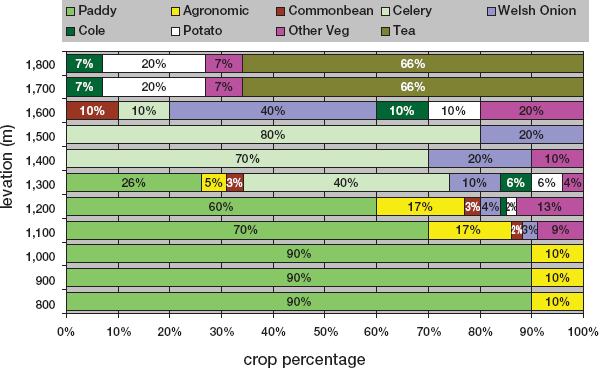Transition in cropping systems from lowland rice-based to temperate vegetable-based systems between 800 and 1,800 m elevation in West Java, Indonesia
Description
[Objectives]
Agriculture in West Java, Indonesia, is characterized by rice paddies in the lowlands and temperate vegetables in the highlands. Intercropping is widly practiced for vegetables (Fig. 1). We developed the "focused transect survey" method and applied it in two production areas to understand the diversity of cropping systems depending on elevation. This method adapts agro-ecosystems analysis for more quantitative assessment, by combining GPS measurement, field transects, farmer participatory methods, and household surveys in a comprehensive rapid survey method. Transect and household surveys were conducted in two temperate vegetableproducing regions in West Java from 2001 to 2002. Horizontal transects of 120 m were placed perpendicular to a vertical transect at intervals of 200 m (Garut) or 100 m (Bandung) elevation from 800 m to 1,800 m and cropping patterns recorded. Cropping patterns over 1999-2001 and reasons for each pattern were obtained by respondent surveys of three farmers for each elevation level.
[Results]
In Garut, over three years, cole crops, white potato, and tomato predominated, with a range of other types of vegetables taken together also forming an important percentage of plantings. On transects in 2001, the most important vegetables were cabbage, carrot, onion, white potato, and other types of vegetables taken together. In Bandung, both over three years and on transects in 2002, celery was more important, followed by onion, cole crops, white potato, and other types of vegetables taken together (Fig. 2). During the three-year period from 1999 until 2001, the transition from rice to vegetables occurred between 1,100 m and 1,200 m in both sites. Paddy was selected primarily due to experience and economics, especially lack of capital. Experience, rotation, and environmental factors were predominant reasons for selection of cole crops and white potato in both sites. Environment and rotation were more important selection factors at the highest altitudes ( 1400 m in Garut, 1300 in Bandung). Costs and capital were more important at lower levels (800 m in Garut, 800-1000 m in Bandung). The proportion of transect length in sole cropping was 3-4 times the proportion in intercropping and trellis culture. In both sites, intercropping was concentrated in the 1,100-1,600 m zone. Border intercropping and in-row intercropping comprised over half of the intercropped plantings in Garut, while trellis culture was the most important type of intercropping in Bandung. Reasons for intercropping were based on horticultural considerations and economic motivations rather than tradition. Plant protection comprised 60-83% of farmer production constraint responses, with insects and diseases equally important.
Figure, table
-
Fig. 1. An example of intercropping. -
Fig. 2. Types of crops at different elevations, 2002.
- Affiliation
-
Japan International Research Center for Agricultural Sciences Development Research Division
- Classification
-
Technical A
- Term of research
-
FY2003 (FY2000-2002)
- Responsible researcher
-
CALDWELL John S. ( Development Research Division )
ISHAQ Iskandar ( West Java Assessment Institute for Agricultural Technology )
- ほか
- Publication, etc.
-
Caldwell, J., Ishaq, I., Sastraatkadia, S., Ruswandi, A., Yamada, M. and Bachrein, S. (2005): Transition in cropping systems from lowland rice-based to temperate vegetable-based systems between 800 and 1,800 m elevation in West Java, Indonesia. JIRCAS Working Paper, No.43 (in press).
- Japanese PDF
-
2003_01_A3_ja.pdf1.31 MB
- English PDF
-
2003_01_A4_en.pdf68.02 KB


